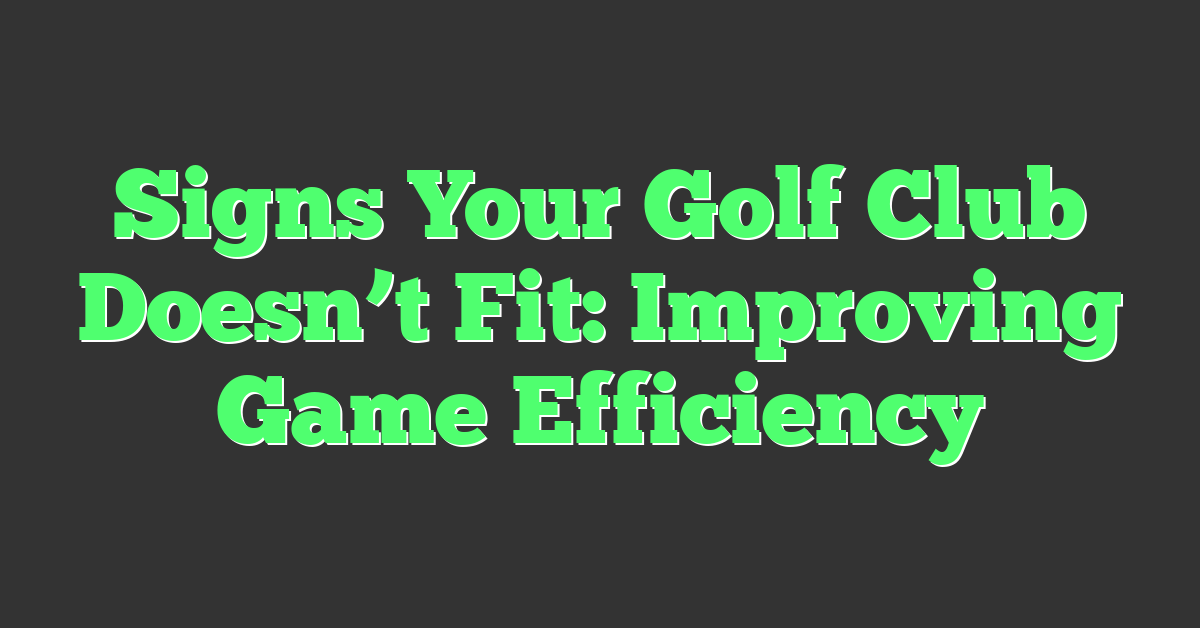
Are you tired of struggling with your golf swing? It might be time to consider if your golf club is the right fit for you. Finding the perfect golf club can make a world of difference in your game. In this article, we’ll explore some key indicators to help you determine if a golf club fits you. From grip size to club length, we’ll cover all the essential factors to ensure you’re using the right equipment for your swing. So, let’s dive in and discover how to know if a golf club fits you!
Have you ever wondered why your shots don’t go as far or as straight as you’d like? The answer might lie in the fit of your golf club. A poorly fitted club can lead to inconsistency and frustration on the course. That’s why it’s crucial to understand the signs that indicate whether a golf club is suitable for you. By paying attention to details such as club weight and shaft flex, you can make informed decisions when selecting your next club. In this article, we’ll walk you through the essential aspects to consider when determining if a golf club fits you.
Importance of Properly Fitting Golf Clubs
As an experienced golfer, you know that having the right golf clubs can make all the difference in your game. But if you’re new to the sport or looking to improve, understanding the importance of properly fitting golf clubs is crucial.
Why does club fitting matter?
- Improved consistency: A club that is properly fitted to your body type, swing speed, and skill level will help you achieve more consistent shots. When your clubs are the right length and weight, you’ll have better control over your swing, resulting in more accurate shots and lower scores.
- Optimized distance: Golf is a game of precision and distance. By having clubs that are customized to your swing, you’ll be able to generate more power and distance. A club with the right shaft flex can help you maximize your swing speed, resulting in longer drives and shorter approach shots.
- Reduced risk of injury: Golf is a physically demanding sport, and using ill-fitted clubs can put unnecessary strain on your body. Having the correct grip size and club length can help prevent injuries such as wrist strain or back pain. When your clubs fit you properly, you’ll be able to swing with more ease and comfort, reducing the risk of strain or injury.
How can you determine if a golf club fits you?
- Grip size: The grip size should allow you to comfortably hold the club without feeling like you have to squeeze too tightly. A grip that is too small can cause your hands to overwork, leading to inconsistent shots. On the other hand, a grip that is too large can hinder your ability to release the club properly.
- Club length: The length of the club should match your height and posture. A club that is too long or too short can negatively impact your swing mechanics and make it difficult to find the sweet spot consistently.
- Weight and shaft flex: The weight of the club should feel balanced in your hands. Additionally, the shaft flex should match your swing speed. If the shaft is too stiff or too flexible, it can affect the timing and accuracy of your shots.
By understanding the importance of properly fitting golf clubs and paying attention to key indicators such as grip size, club length, weight, and shaft flex, you can make informed decisions when selecting your clubs. Remember, the right equipment can help you become a better golfer and shoot lower scores. So, take the
Signs that Your Golf Club Doesn’t Fit
As a golfer who wants to improve your game and shoot lower scores, it’s crucial to ensure that your golf clubs are the right fit for you. Using clubs that don’t suit your swing can negatively impact your performance on the course. Here are some signs that your golf club doesn’t fit:
1. Inconsistent ball flight: If you notice that your shots have varying trajectories, it could be a sign that your club doesn’t fit you properly. A club that is too long or too short can cause you to make compensations in your swing, leading to inconsistent ball flight.
2. Difficulty with distance control: If you find it challenging to control the distance of your shots, it may be due to an ill-fitting club. For example, a club with the wrong shaft flex can make it difficult to generate the proper amount of power and control needed for consistent distance.
3. Grip discomfort: Your club’s grip is your connection to the club, and if it doesn’t feel comfortable in your hands, it can affect your swing. A grip that is too small or too large can lead to tension in your hands and wrists, resulting in decreased shot accuracy.
4. Inability to find the club’s sweet spot: Every club has a sweet spot, which is the area on the clubface where you achieve optimal distance and accuracy. If you consistently struggle to find the sweet spot with your club, it could be a sign that the club’s length or weight is not suited to your swing.
5. Increased risk of injury: Using a club that doesn’t fit you properly can put unnecessary strain on your body, increasing the risk of injury. For example, a club that is too heavy or has the wrong shaft flex can cause undue stress on your muscles and joints.
By being aware of these signs, you can determine if your golf club isn’t the right fit for you. Remember, finding the right club can make a significant difference in your game, leading to improved consistency, optimized distance, and reduced risk of injury. In the next section, we’ll explore the key indicators to help you determine if a golf club fits you.
How to Measure Proper Club Length
As a low handicap golfer who has played your whole life, you know that having the right club length is crucial for improving your game and shooting lower scores. If your golf club is too long or too short, it can throw off your swing mechanics and affect your consistency. So, how do you measure the proper club length?
- Stand up straight: Start by standing up straight with your arms relaxed at your sides. This is your natural posture, and it’s important to measure your club length based on this position.
- Measure your wrist-to-floor distance: Have someone help you measure the distance from your wrist to the floor while you are standing in your natural posture. This measurement will give you a good starting point for determining the appropriate club length.
- Consider your height and arm length: While the wrist-to-floor measurement is a good starting point, it’s also important to consider your height and arm length. Taller golfers typically require longer clubs, while shorter golfers may benefit from shorter clubs. Additionally, if you have long arms relative to your height, you may need longer clubs, and vice versa.
- Get fitted by a professional: To ensure the most accurate measurement, it’s best to get fitted by a professional club fitter. They have the expertise and tools to measure your swing dynamics and recommend the best club length for you.
Remember, having the proper club length is just one aspect of finding the right golf club for you. Grip size, shaft flex, and clubhead design also play a role in optimizing your performance on the course. So, if you’re serious about becoming a better golfer and shooting lower scores, investing in a club fitting session is definitely worth considering.
By measuring the proper club length and getting fitted by a professional, you can ensure that your clubs are tailored to your unique swing characteristics. This will help you achieve better consistency, improved distance control, and ultimately, lower scores. So, don’t overlook the importance of having the right club length in your golf bag.
Determining the Right Club Lie Angle
As a golfer who is constantly striving to improve your game and shoot lower scores, it’s important to understand the role that the lie angle of your golf club plays in your performance. The lie angle refers to the angle between the shaft of the club and the sole of the clubhead when the club is resting on the ground. Having the correct lie angle is crucial for consistent ball striking and optimal shot trajectory. Here are a few things to consider when determining the right club lie angle:
1. Swing Plane and Impact
The lie angle of your golf club directly affects the path of your swing and the angle at which the clubface contacts the ball at impact. If the lie angle is too upright, the toe of the club will dig into the ground, causing the clubface to close and resulting in shots that veer to the left for right-handed golfers (and vice versa for left-handed golfers). On the other hand, if the lie angle is too flat, the heel of the club will dig into the ground, causing the clubface to open and resulting in shots that veer to the right for right-handed golfers (and vice versa for left-handed golfers).

2. Impact Tape Test
One way to determine if your club lie angle is correct is by performing an impact tape test. Apply impact tape to the sole of your club and hit a few shots off a lie board or a hard surface. Examine the marks on the impact tape after each shot. If the mark is centered on the clubface, the lie angle is likely correct. However, if the mark is consistently towards the heel or toe of the clubface, it may indicate that the lie angle needs adjustment.
3. Professional Club Fitting
For the most accurate determination of the right club lie angle, it’s highly recommended to seek professional club fitting. A club fitting expert will use advanced technology and expertise to analyze your swing and determine the optimal lie angle for your clubs. They may also consider factors such as your swing speed, attack angle, and body measurements to ensure the best fit.
By understanding and determining the right club lie angle for your swing, you can greatly improve your consistency and shot-making ability on the golf course. Remember, golf is a game of precision, and having the right equipment that fits you properly is a crucial step towards achieving your goals. So take the time to assess your club lie angles and consider getting fitted by a

Grip Size and Its Impact on Club Fit
As a golfer who is always striving to improve your game and shoot lower scores, it’s important to consider the grip size of your golf club when determining if it fits you properly. The grip is the only part of the club that you actually touch, so having the right grip size can greatly impact your performance on the course. Here’s why grip size is important and how it affects your club fit:
- Comfort and Control: The grip size directly affects how comfortable you feel holding the club and how much control you have over it. If the grip is too small, you may find yourself gripping the club tightly, which can lead to tension in your hands and wrists, resulting in inconsistent shots. On the other hand, if the grip is too large, you may struggle to release the club properly through impact, leading to a loss of control and accuracy.
- Shot Shape: The size of the grip can also influence the shape of your shots. A smaller grip tends to promote a fade or slice, while a larger grip can encourage a draw or hook. By finding the right grip size that suits your swing and desired shot shape, you can enhance your ability to shape the ball and hit more accurate shots.
- Swing Efficiency: A proper grip size allows for better swing mechanics and efficiency. With the right grip size, you’ll be able to maintain a more neutral grip position, preventing unnecessary compensations in your swing. This can lead to improved swing tempo, better clubface control, and ultimately, more consistent ball striking.
To determine the correct grip size for you, it’s recommended to get fitted by a professional. They will take measurements of your hand size and consider factors such as your swing style and shot preferences. This will ensure that you have the right grip size that optimizes your comfort, control, and overall performance on the course.
Remember, a golf club that fits you properly will provide you with better consistency, improved distance control, and ultimately help you shoot lower scores. So don’t overlook the importance of grip size when evaluating if your golf club is the right fit for you.
Customizing Your Club for Optimal Performance
As a golfer who wants to improve your game and shoot lower scores, it’s important to understand that finding the right golf club goes beyond just choosing the right grip size. Customizing your club to fit you perfectly can have a significant impact on your performance on the course. Here are a few key aspects to consider when customizing your club for optimal performance:
1. Shaft Flexibility
The flexibility of your golf club’s shaft can greatly affect the way you swing and the distance you achieve with each shot. A shaft that is too stiff can cause your shots to feel rigid and lack distance, while a shaft that is too flexible can result in inconsistency and loss of control. Getting fitted for the right shaft flexibility based on your swing speed and swing type can help you achieve better consistency and maximize your distance potential.

2. Club Length
The length of your golf club can also impact your swing and overall performance. A club that is too long can lead to a loss of control and accuracy, while a club that is too short can cause you to hunch over, resulting in inconsistent ball striking. Getting properly fitted for the right club length ensures that you maintain the correct posture and maximize your chance of hitting the ball solidly and consistently.
3. Clubhead Design
The design and characteristics of the clubhead can also play a significant role in your performance. Different clubhead designs offer varying levels of forgiveness, workability, and distance potential. For example, a larger clubhead with a higher moment of inertia (MOI) can provide more forgiveness on off-center hits, while a smaller clubhead with a lower MOI allows for greater shot shaping ability. Understanding your own preferences and getting fitted for the right clubhead design can help you optimize your performance on the course.
4. Loft and Lie Angles
Lastly, the loft and lie angles of your golf club can affect the trajectory and direction of your shots. A club with incorrect loft and lie angles can result in inconsistent ball flight and missed targets. Getting your club’s loft and lie angles adjusted to fit your swing style and shot preferences can help you achieve more accurate and consistent shots.
Customizing your golf club for optimal performance is a crucial step towards becoming a better golfer and shooting lower scores. By considering factors such as shaft flexibility, club length, clubhead design, and loft and lie angles, you can ensure that your golf club fits you perfectly
Conclusion
Finding the right golf club is crucial for enhancing your game. In this article, we have explored the signs that indicate a poor club fit, including inconsistent ball flight, difficulty with distance control, grip discomfort, inability to find the sweet spot, and an increased risk of injury. We have also emphasized the significance of grip size in club fit, as it directly impacts comfort, control, shot shape, and swing efficiency.
Furthermore, we have discussed other important factors to consider when customizing your club for optimal performance, such as shaft flexibility, club length, clubhead design, and loft and lie angles. By tailoring these aspects to suit your swing style and shot preferences, you can maximize your performance on the course and achieve greater consistency, improved distance control, and ultimately lower scores.
Remember, a golf club that fits you well can make a world of difference in your game. So, take the time to assess your current club fit and consider making necessary adjustments. With a properly fitted golf club, you’ll be well on your way to reaching your full potential and enjoying the game to the fullest. Happy golfing!










